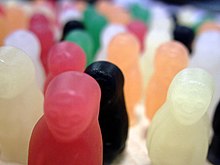Jelly Babies: Difference between revisions
Undid revision 268235019 by Beanboy911 (talk) to remove unsourced |
Beanboy911 (talk | contribs) No edit summary |
||
| Line 1: | Line 1: | ||
{{Refimprove|date=March 2008}} |
{{Refimprove|date=March 2008}} |
||
[[Image:Jellybabies.jpg|thumb|Bassett Jelly Babies]] |
[[Image:Jellybabies.jpg|thumb|Bassett Jelly Babies]] |
||
BBBBBBBBBBBBBBBBEEEEEEEEEEEEEEEEAAAAAAAAAAAAANNNNNNNNNNNNNSSSSSSSSSSSS |
|||
'''Jelly babies''' are a type of soft [[confectionery]] that look like little [[infant|babies]] in a variety of colours. They are very popular in the [[United Kingdom]]. There are currently several companies that make jelly babies, most predominantly [[Trebor Bassett]] (part of the Cadbury Group of companies, and famous for their [[liquorice allsorts]]) and also Rowntree ([[Nestlé]]). |
'''Jelly babies''' are a type of soft [[confectionery]] that look like little [[infant|babies]] in a variety of colours. They are very popular in the [[United Kingdom]]. There are currently several companies that make jelly babies, most predominantly [[Trebor Bassett]] (part of the Cadbury Group of companies, and famous for their [[liquorice allsorts]]) and also Rowntree ([[Nestlé]]). |
||
Revision as of 12:08, 3 February 2009
This article needs additional citations for verification. (March 2008) |
BBBBBBBBBBBBBBBBEEEEEEEEEEEEEEEEAAAAAAAAAAAAANNNNNNNNNNNNNSSSSSSSSSSSS Jelly babies are a type of soft confectionery that look like little babies in a variety of colours. They are very popular in the United Kingdom. There are currently several companies that make jelly babies, most predominantly Trebor Bassett (part of the Cadbury Group of companies, and famous for their liquorice allsorts) and also Rowntree (Nestlé).
Jelly Babies were launched by Bassett's in 1919 in Sheffield as "Peace Babies" to mark the end of World War I. Production was suspended during World War II due to wartime shortages and the fact that the name had largely become ironic. In 1953 the product was relaunched as "Jelly Babies". In March 1989 Bassett's were taken over by Cadbury Schweppes who had earlier acquired the Trebor brand.
Jelly Babies manufactured in the United Kingdom tend to be dusted in starch which is left over from the manufacturing process where it is used to aid release from the mould. Jelly Babies of Australian manufacture generally lack this coating.
Like many sweets, they contain gelatin and are thus not suitable for vegetarians.
A popular science class experiment is to put them in a strong oxidising agent, and see the resulting spectacular reaction. The experiment is commonly referred to as: "Screaming jelly babies."

Each Bassett's Jelly Baby now has an individual name and shape, colour and flavour: Brilliant (red - strawberry), Bubbles (yellow - lemon), Baby Bonny (pink - raspberry), Boofuls (green - lime), Bigheart (purple - blackcurrant) and Bumper (orange). The introduction of different shapes and names was a new innovation, circa 1989, prior to which all colours of jelly baby were a uniform shape.
Jelly Babies are similar in appearance to Gummi bears, which are better known outside of the United Kingdom.
According to the Marvel comics Doctor Who issue # 21 (published in 1986), Jelly Babies are not sold in the United States because of a U.S. Food and Drug Administration regulation. The FDA determined that one or more of the food colorings used in making jelly babies are carcinogenic. Therefore the importation of the confection into the United States was banned. As a result of changes in FDA regulations, jelly babies are now imported and sold in the U.S. [citation needed]
In popular culture
- Jelly babies were featured frequently on the science fiction TV series Doctor Who in the late 1970s, as they were a favourite confection of the Fourth Doctor, played by Tom Baker. During his era of the series, "Would you like a Jelly Baby?" was a frequently repeated catchphrase, often used by the character to "break the ice" in tense meetings. The Second Doctor, Sixth Doctor, Seventh Doctor and Eighth Doctor also enjoyed jelly babies, as did the Master in his sixth incarnation.
- George Harrison's favourite sweet were Jelly Babies. Many fans of the Beatles used to throw Jelly Babies at them during shows. However when he was in America, he was often showered with Jelly Beans, which are much harder than Jelly Babies.
- The character of Basil Brush is shown to have a great liking for jelly babies, and it is a major theme running throughout each series.
- In March 1999, a company released an unofficial novelty version of the sweet, shaped like elderly people and called "Jellyatrics". They were initially criticised by Age Concern for giving a cliched portrayal of the elderly.[1] but are currently sold by some branches of that organisation..[2]
References
- ^ Martin, Nicole (18 March 1999). "Jelly babies become Jellyatrics at the ripe old age of 80". Telegraph. Retrieved 2008-12-18.
- ^ "The Jellyatrics are here".
{{cite news}}: Cite has empty unknown parameter:|1=(help)
